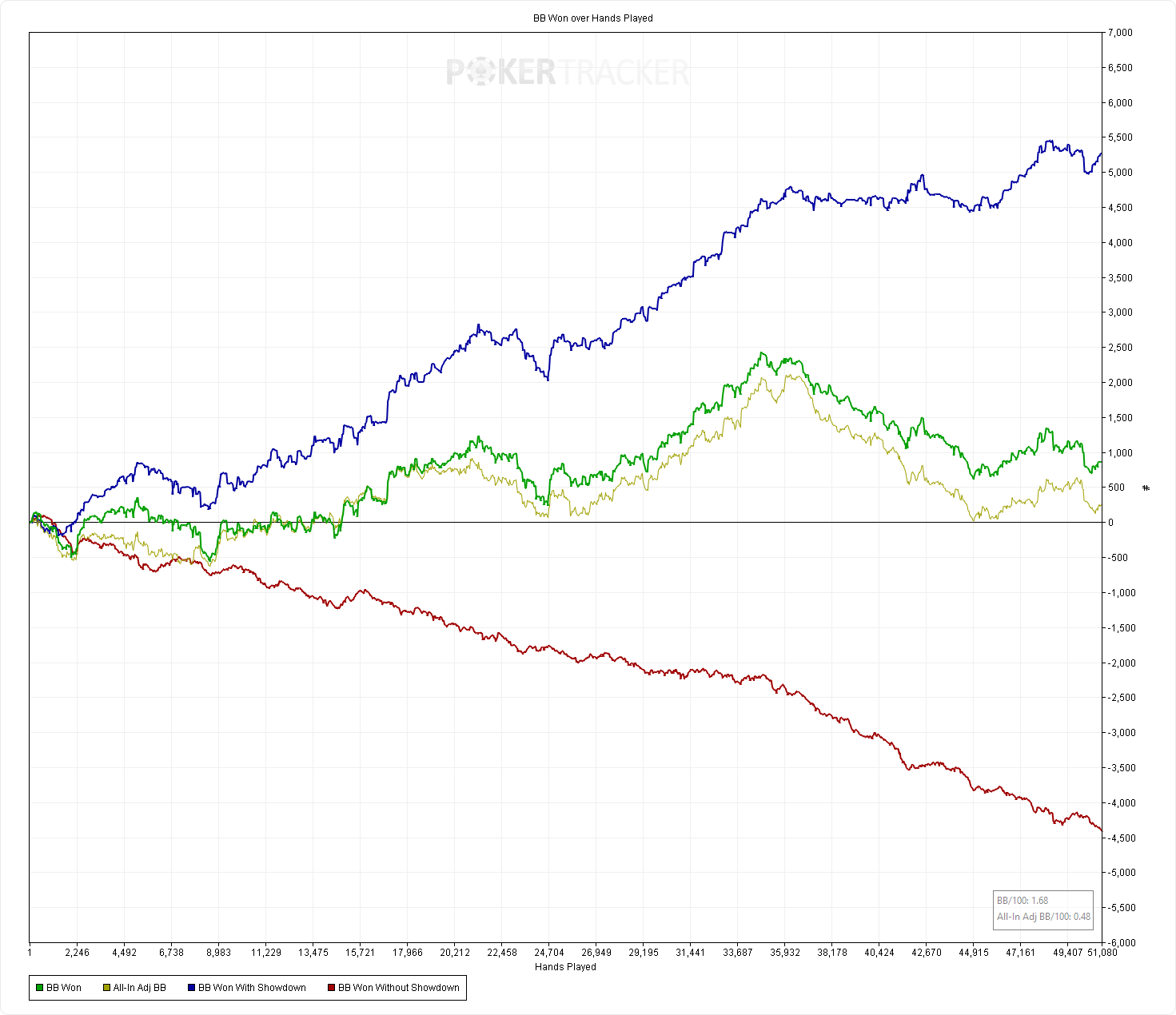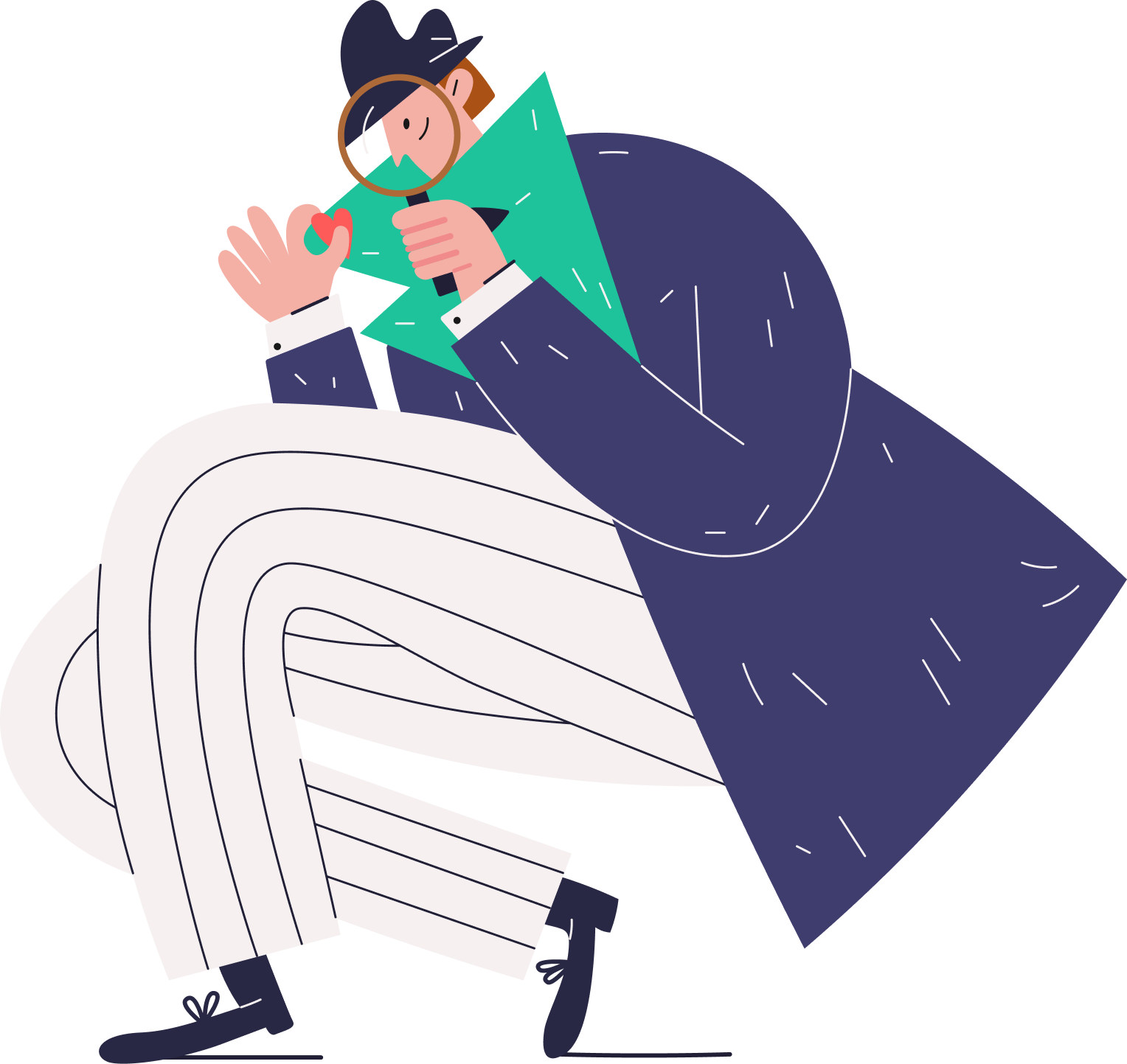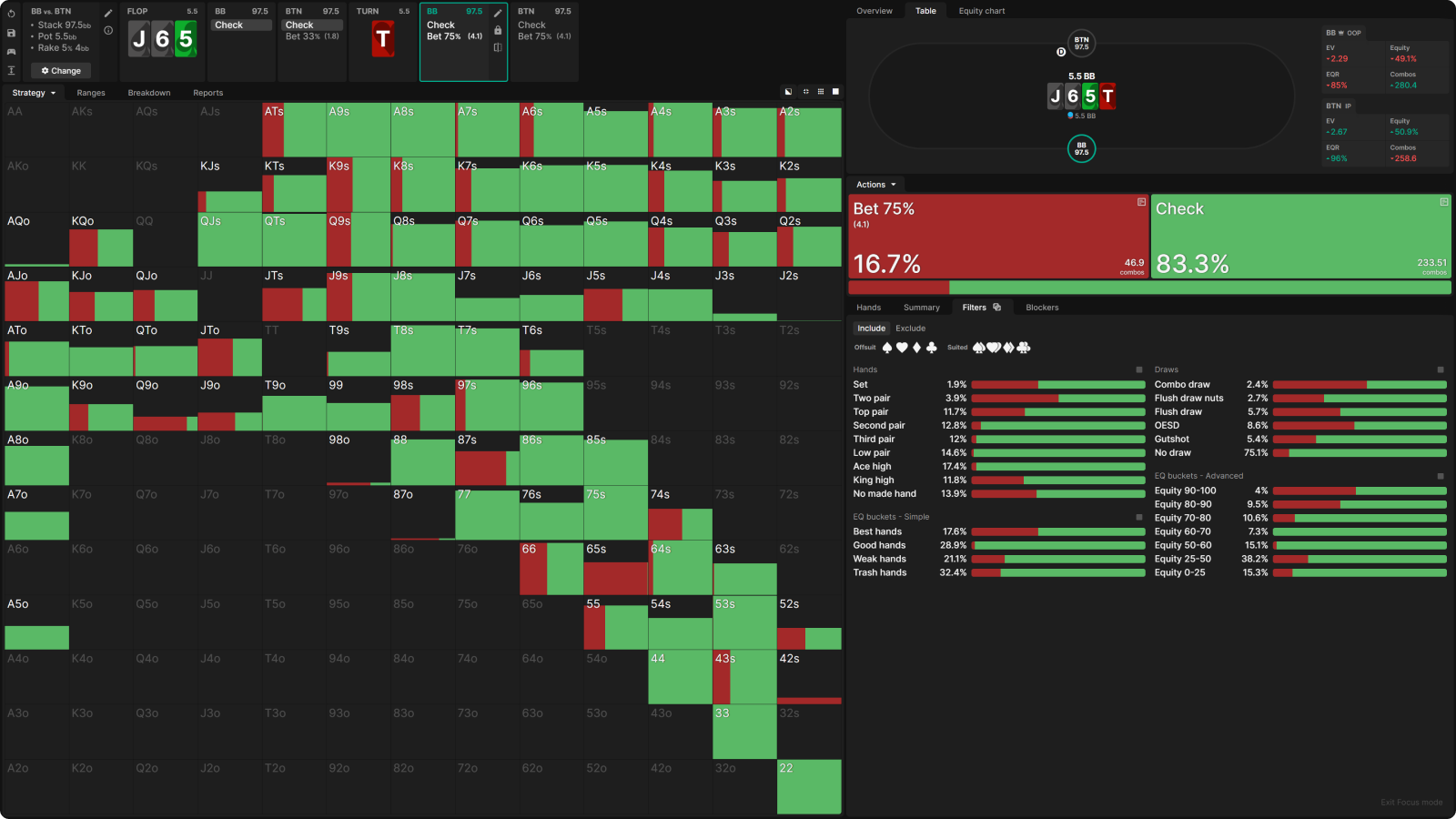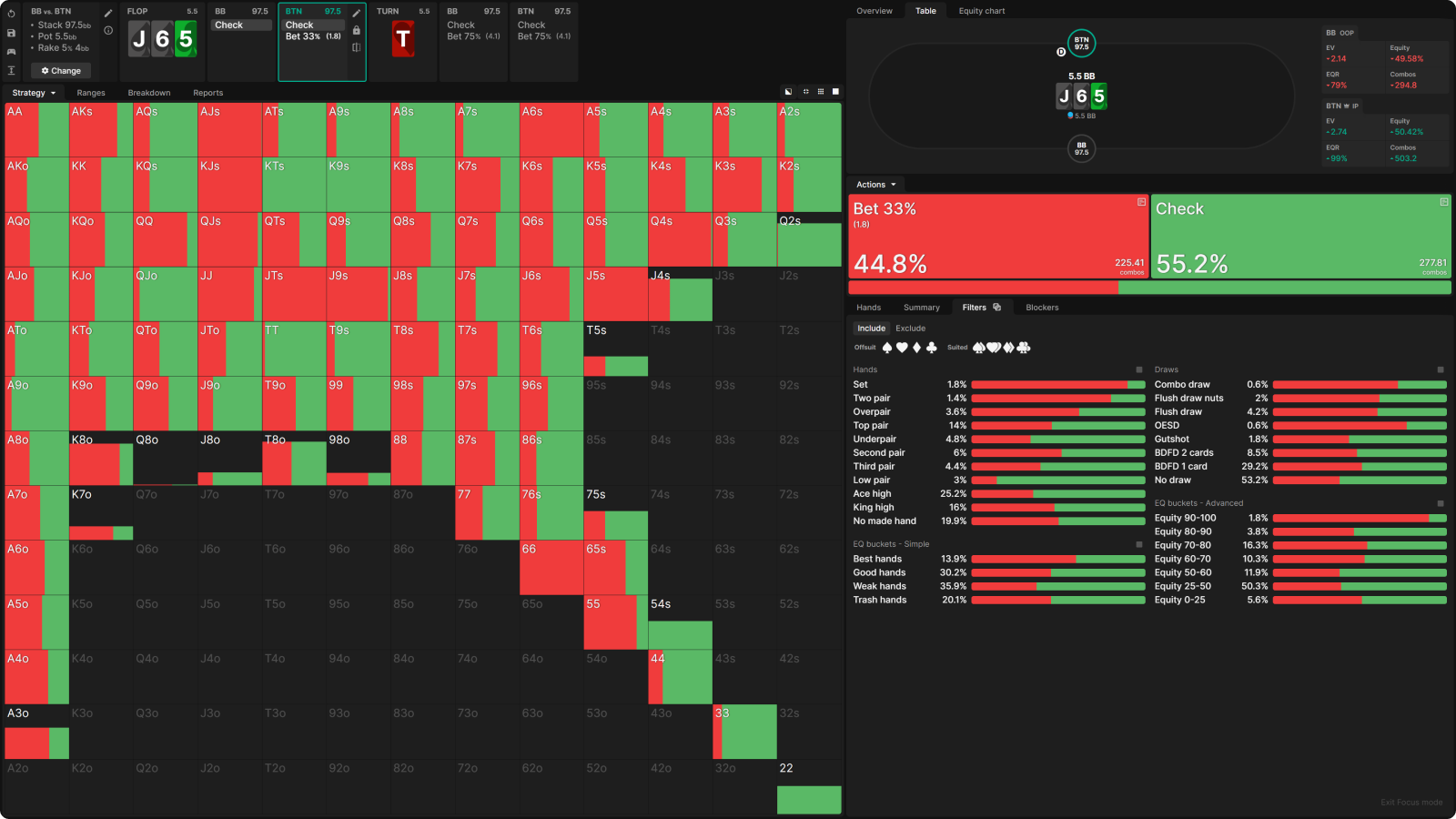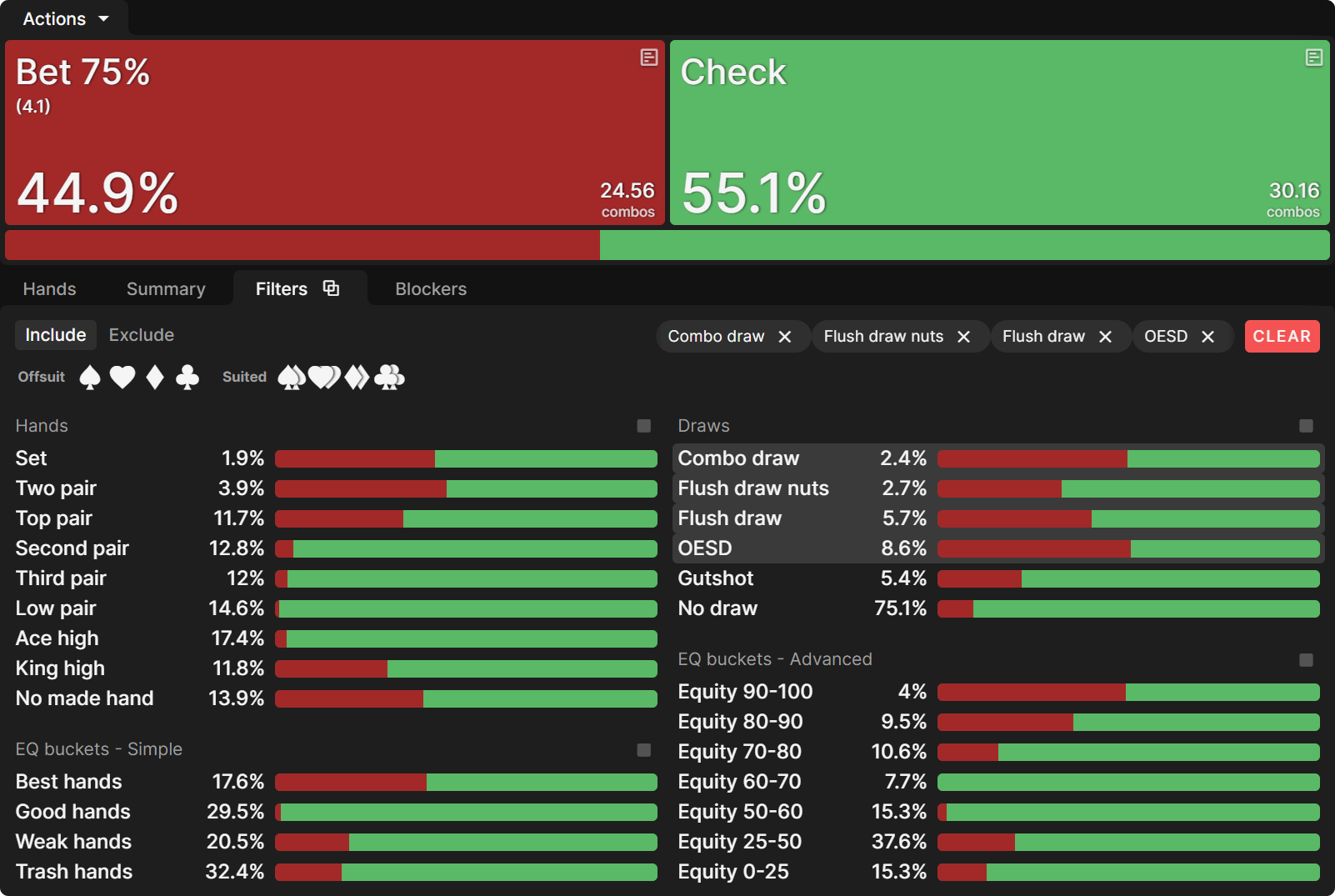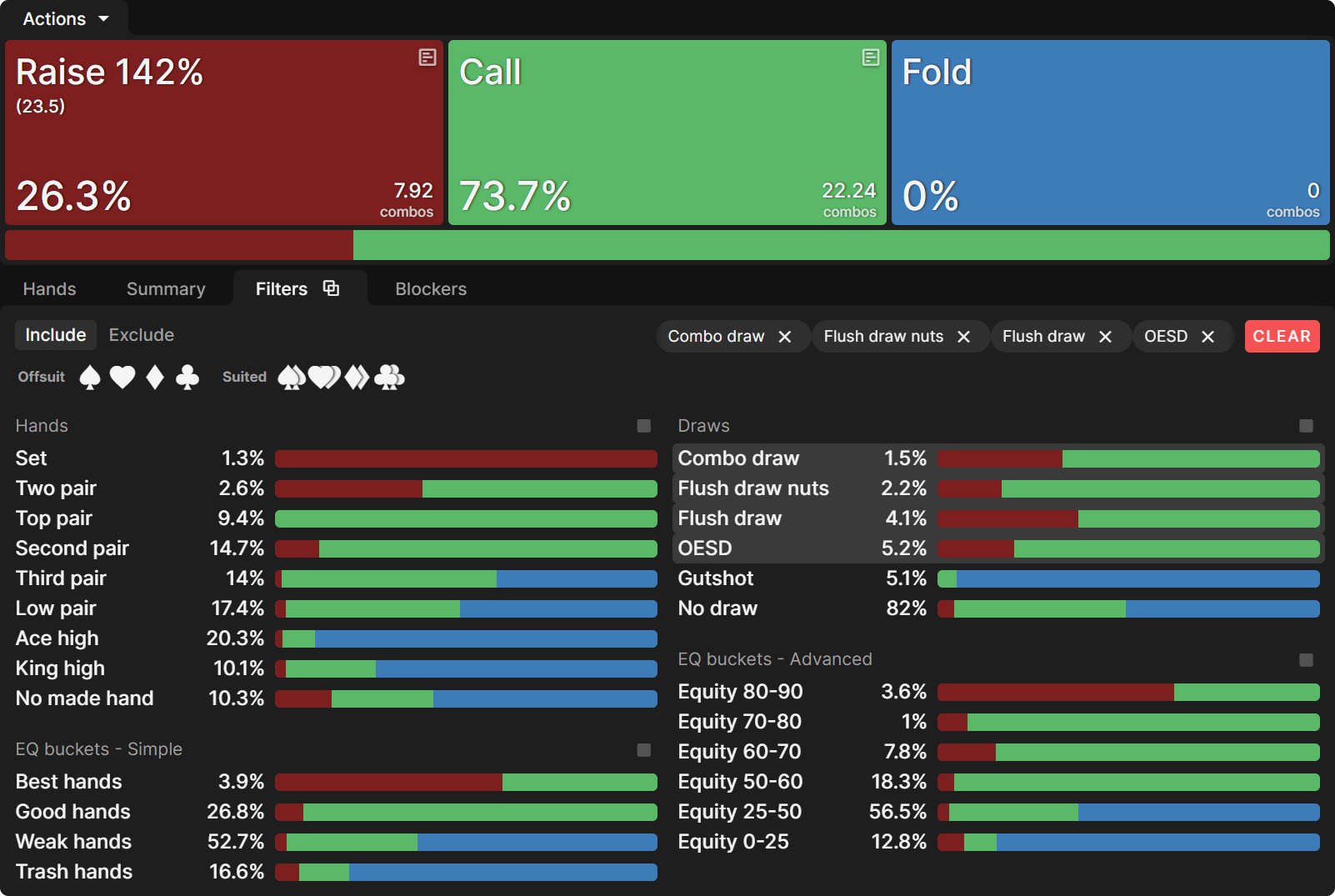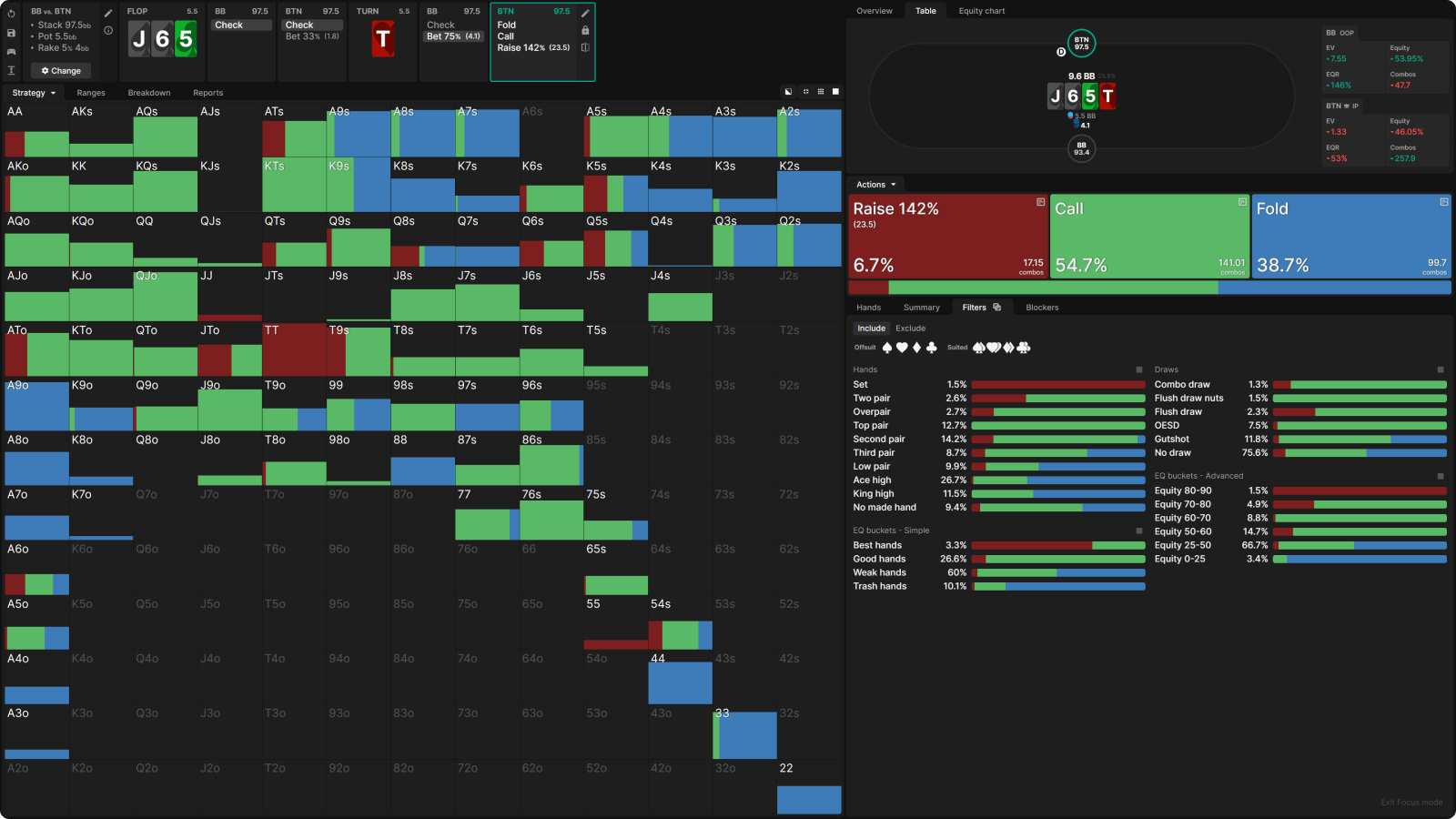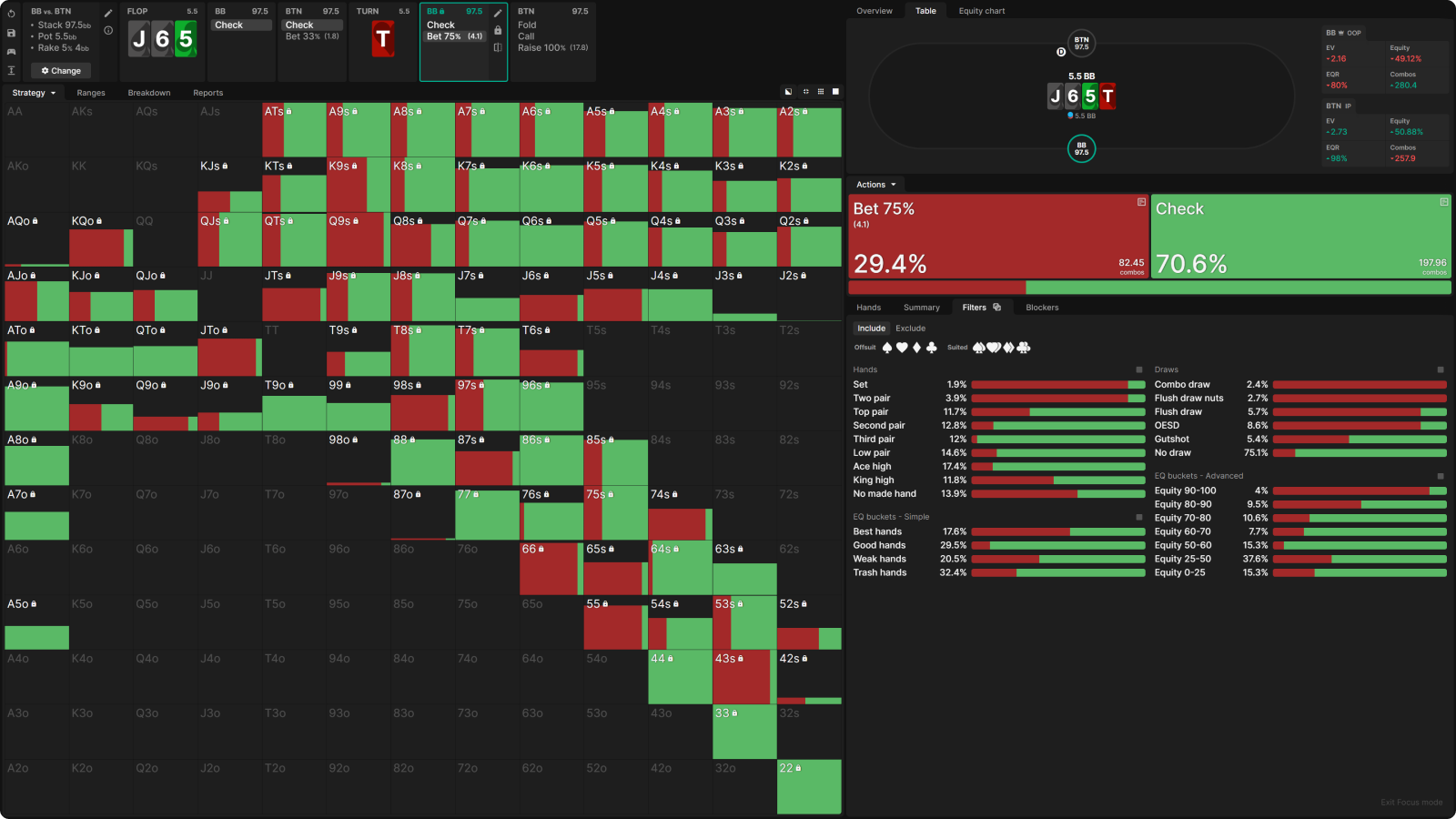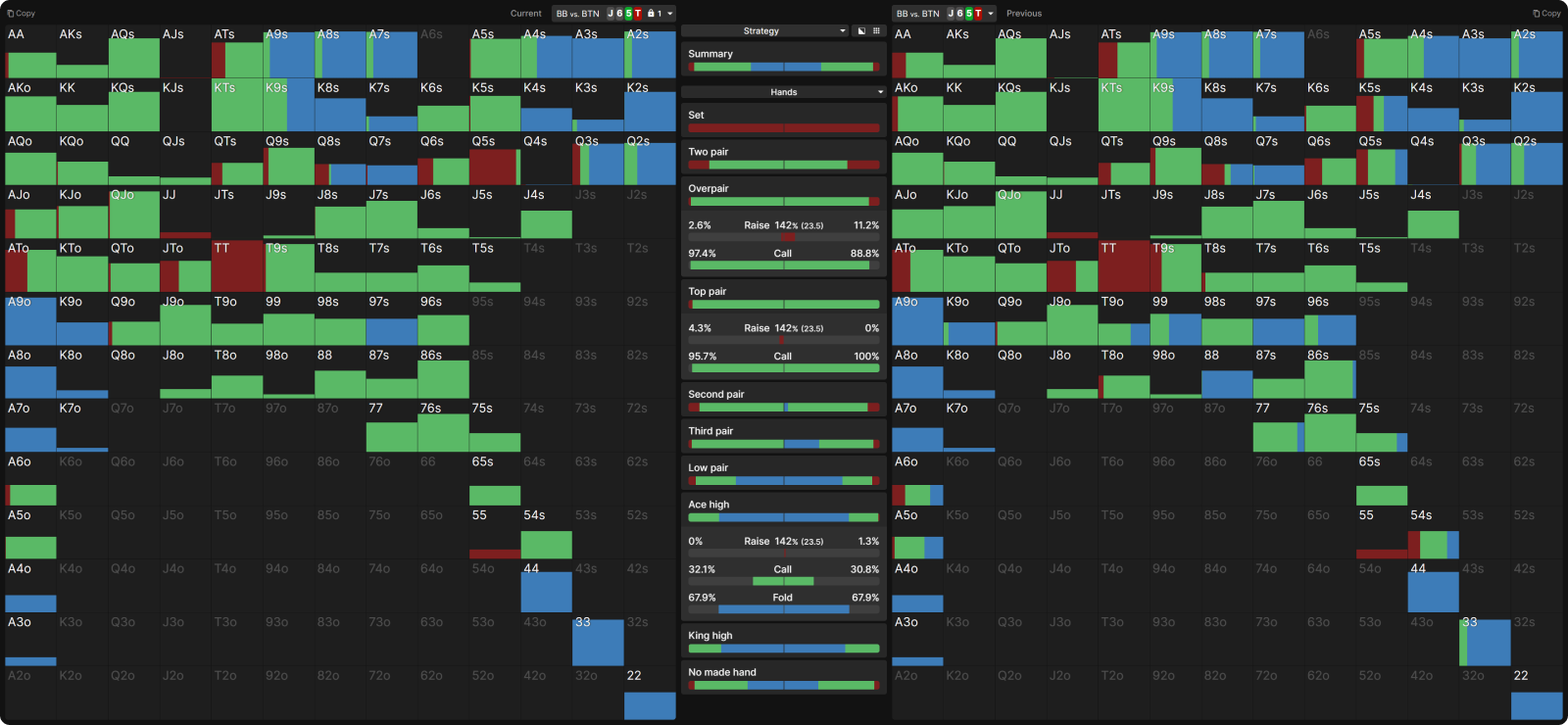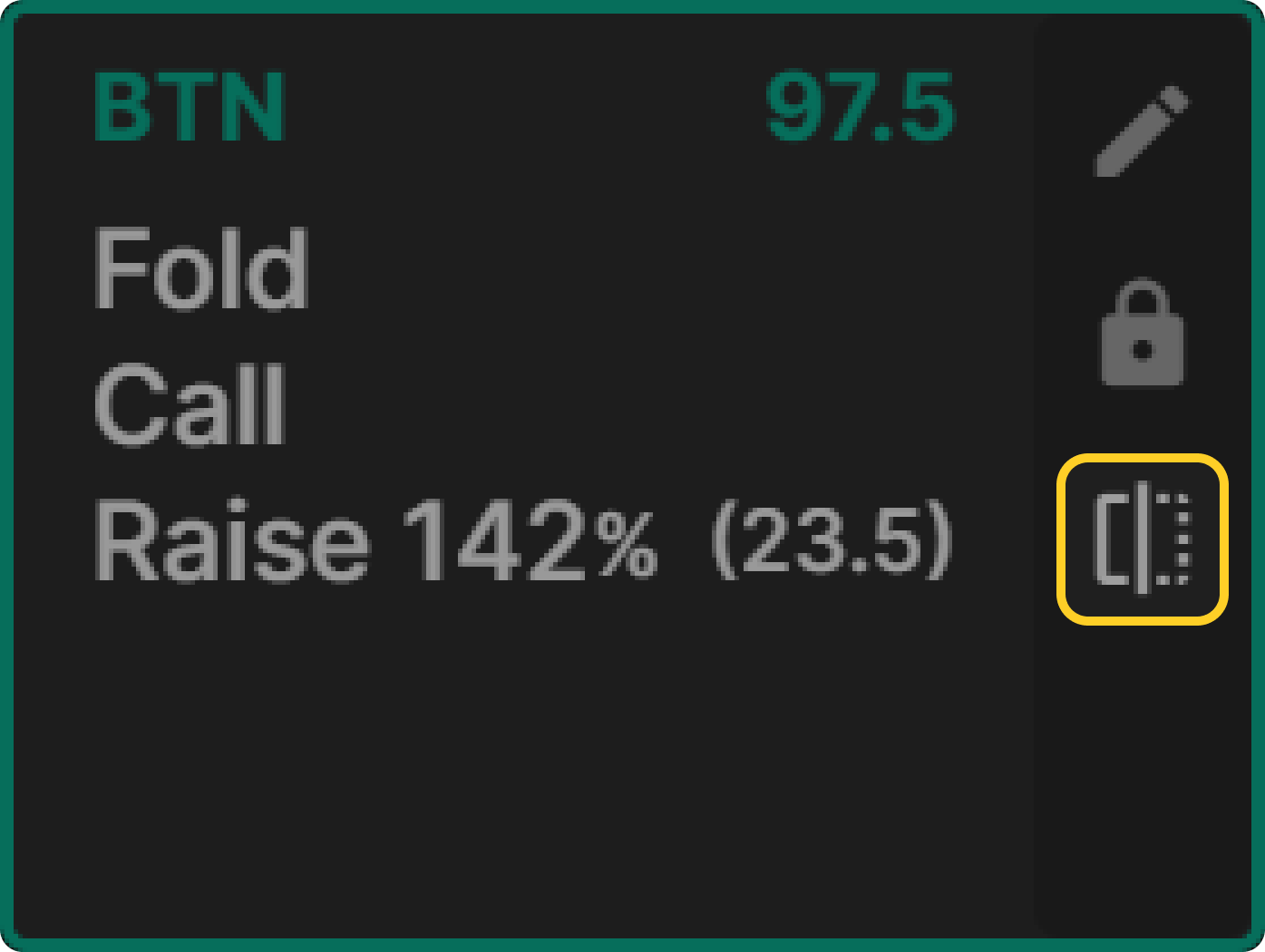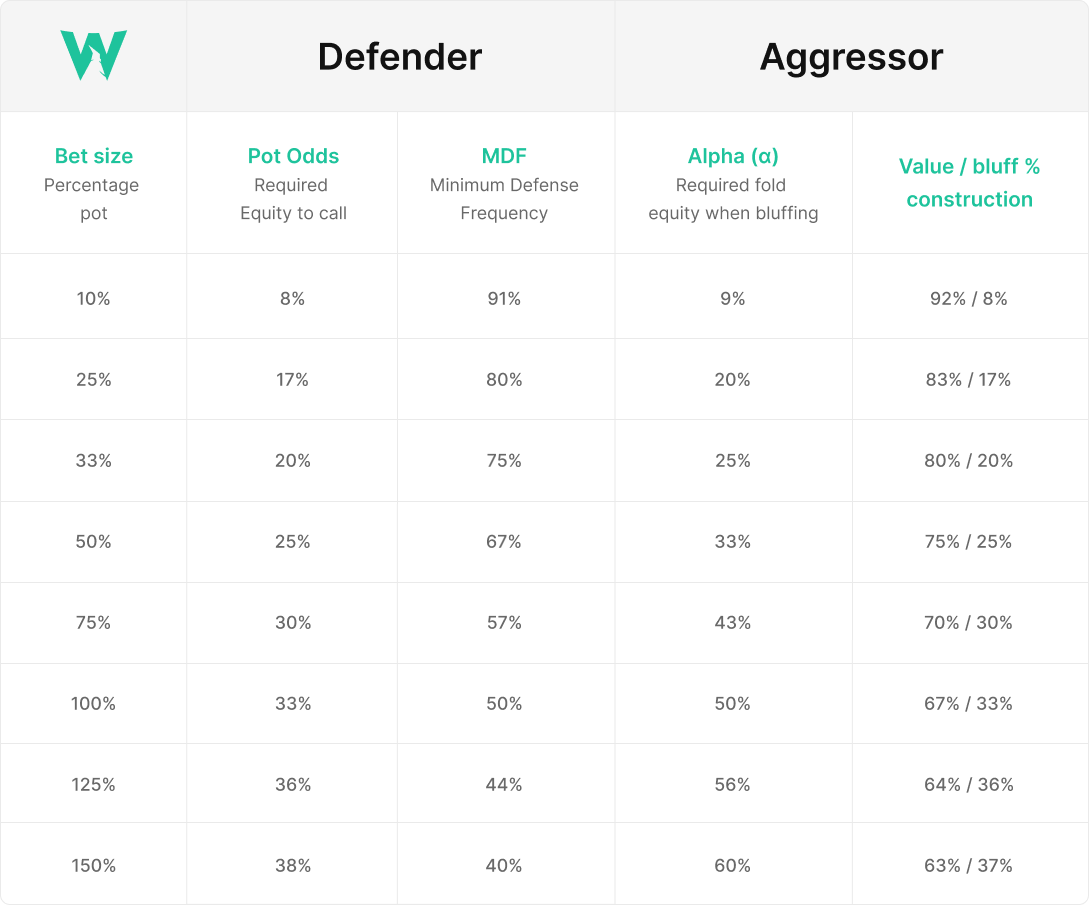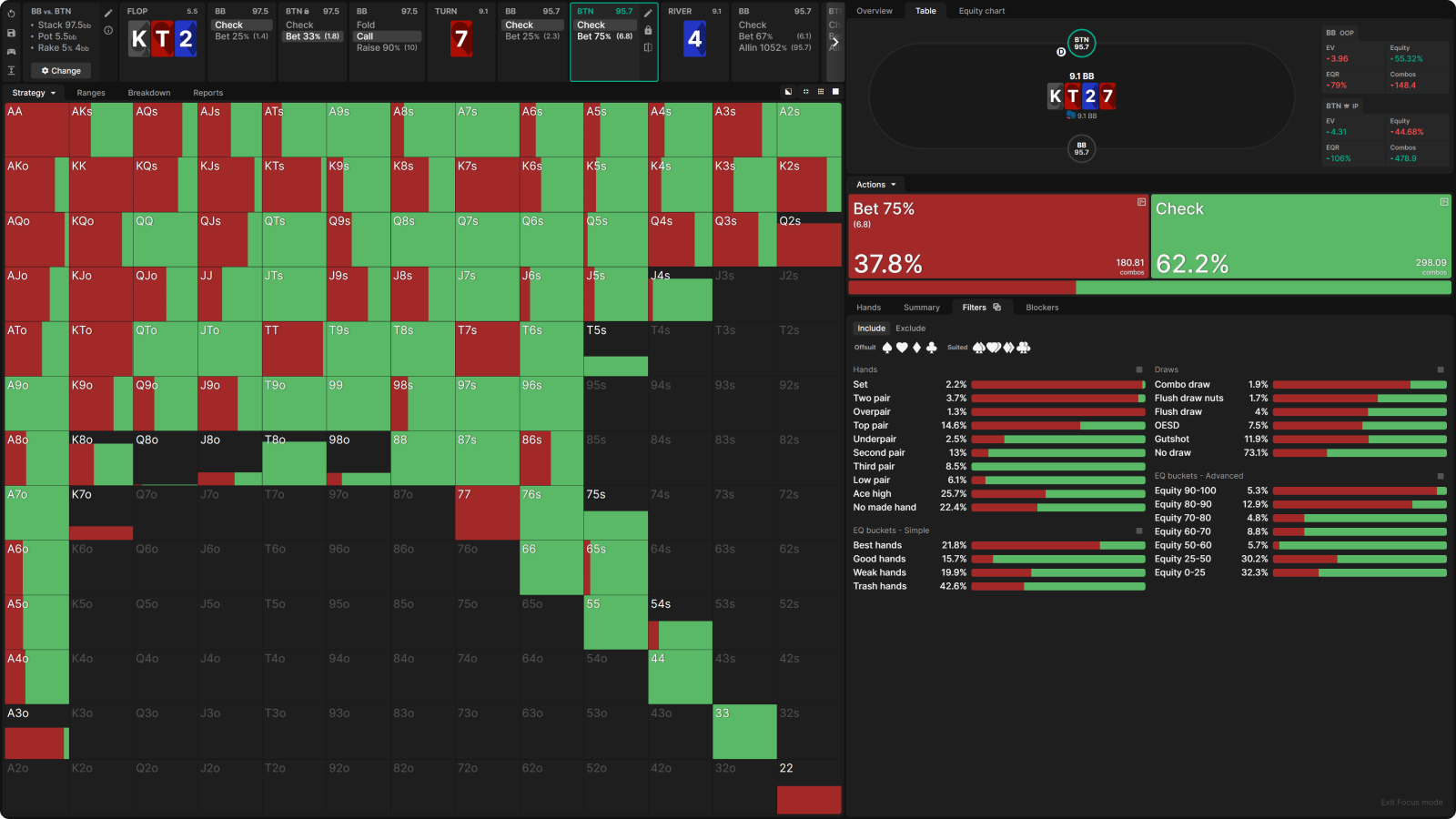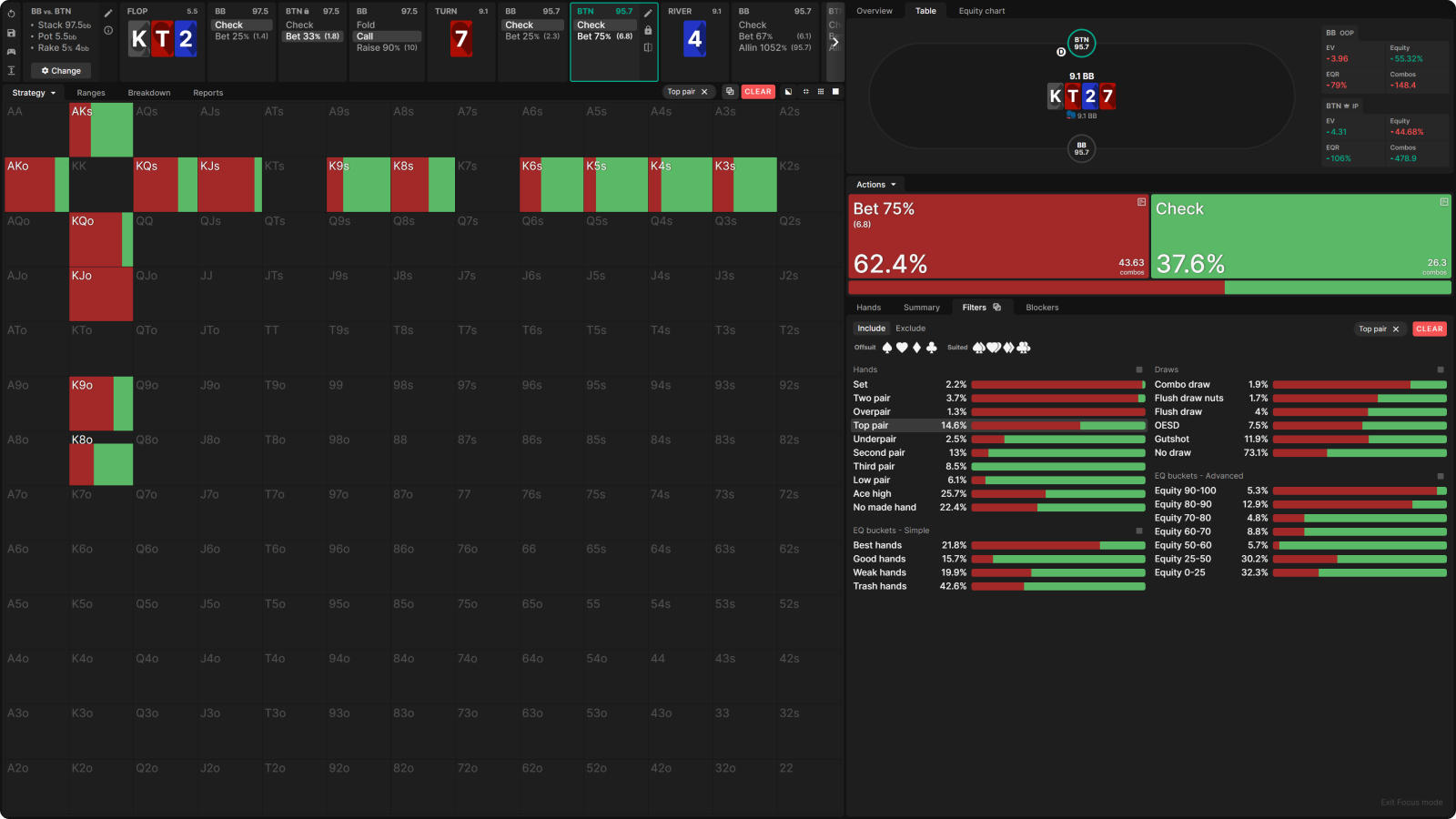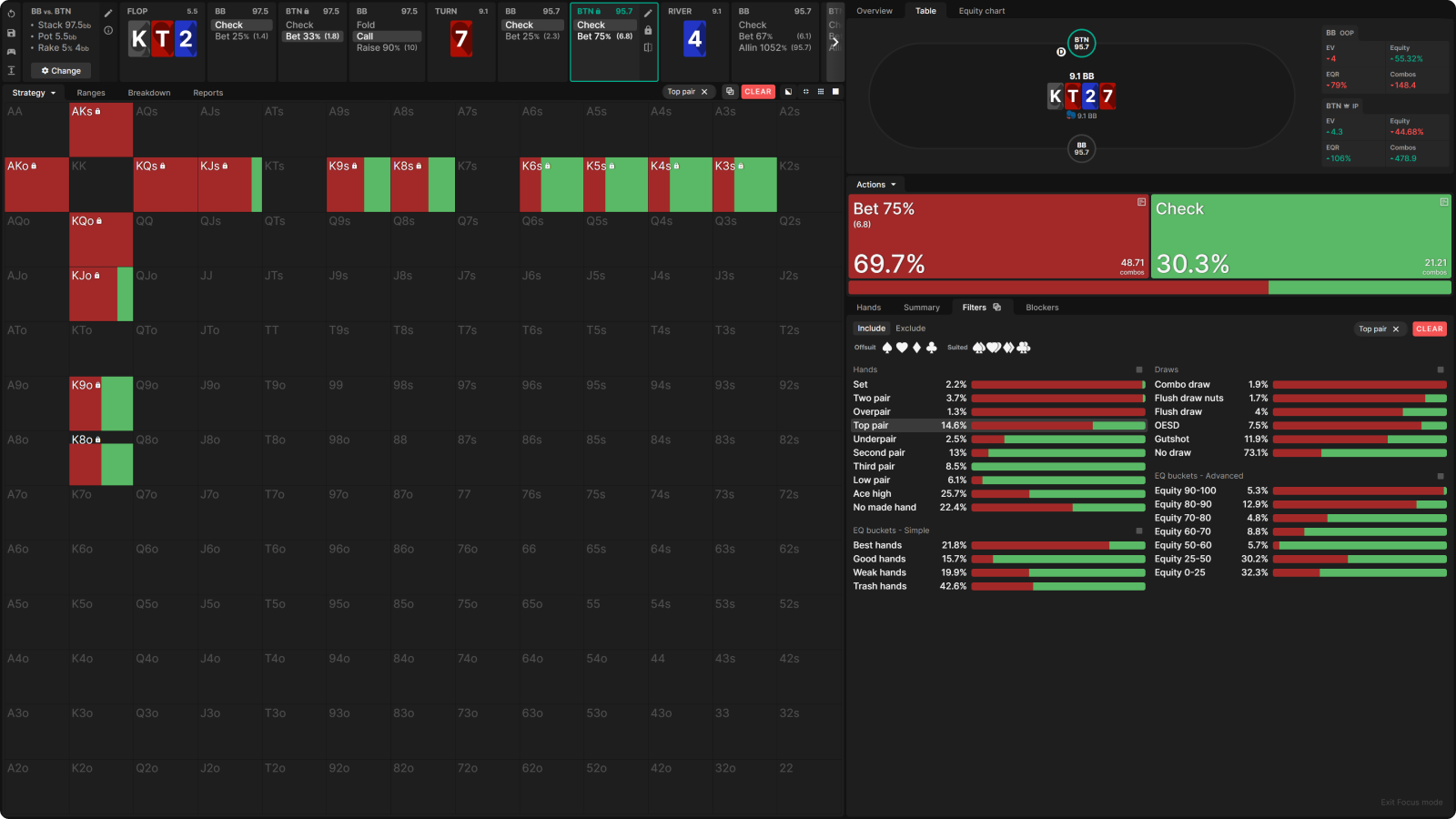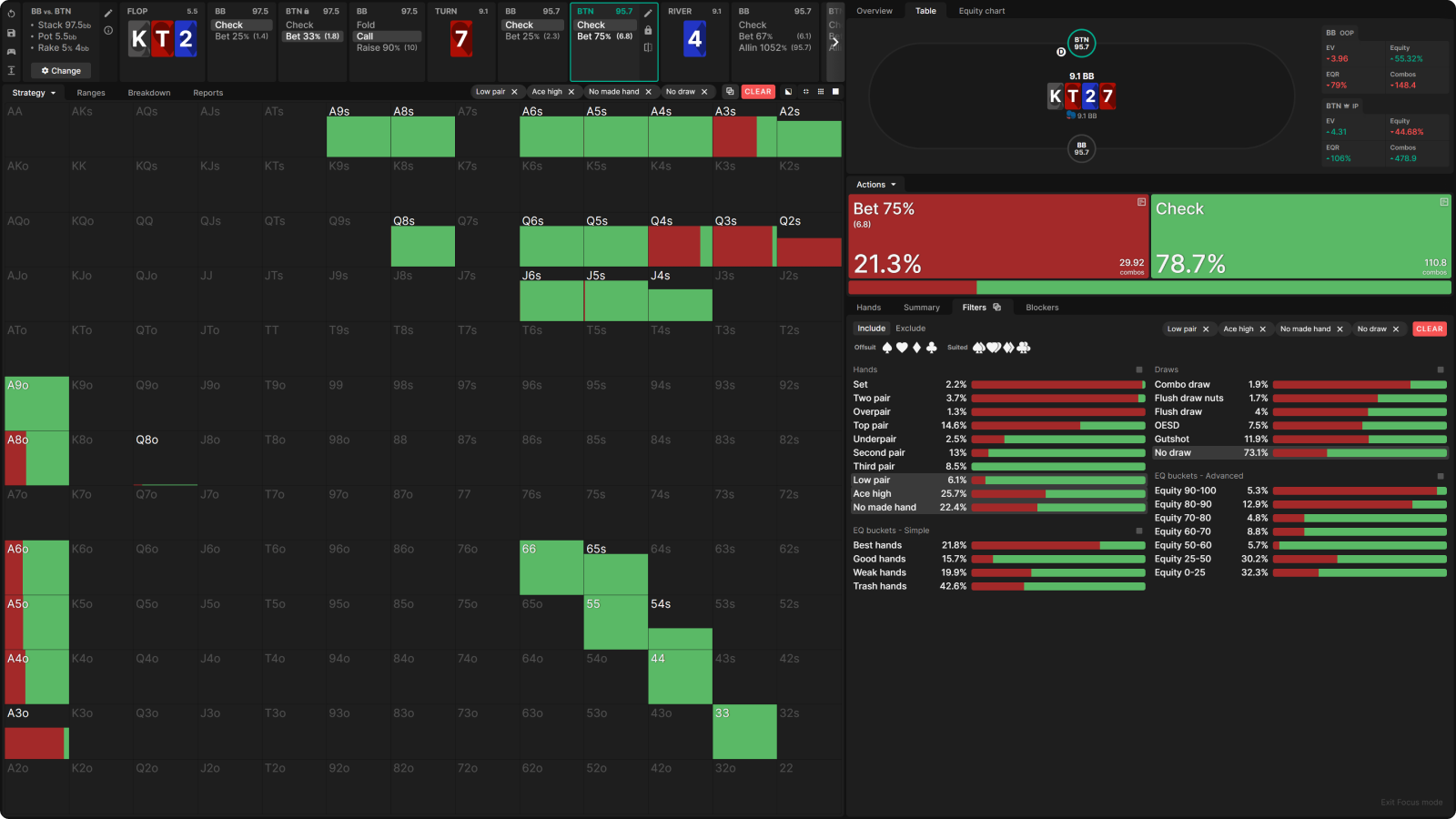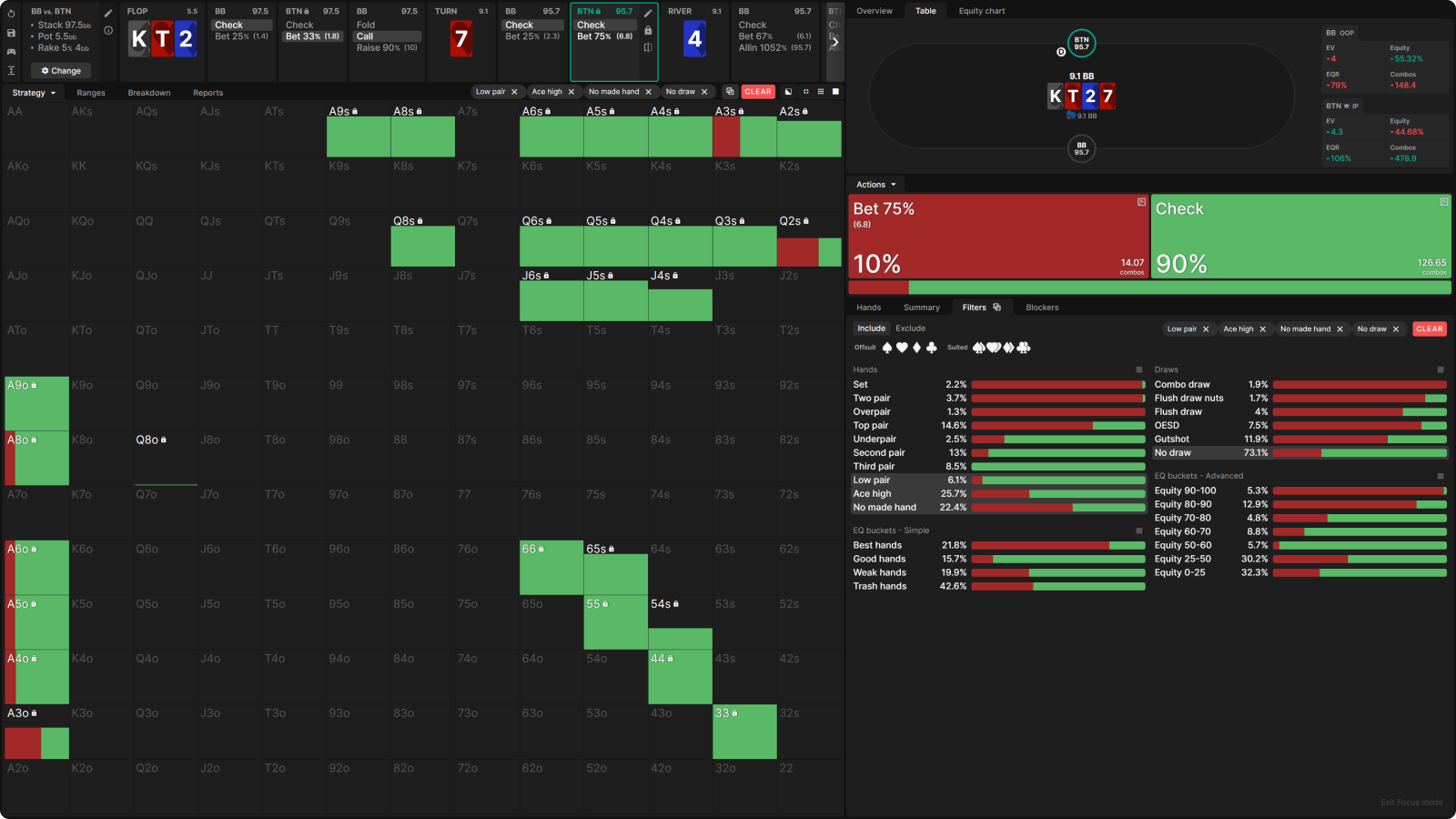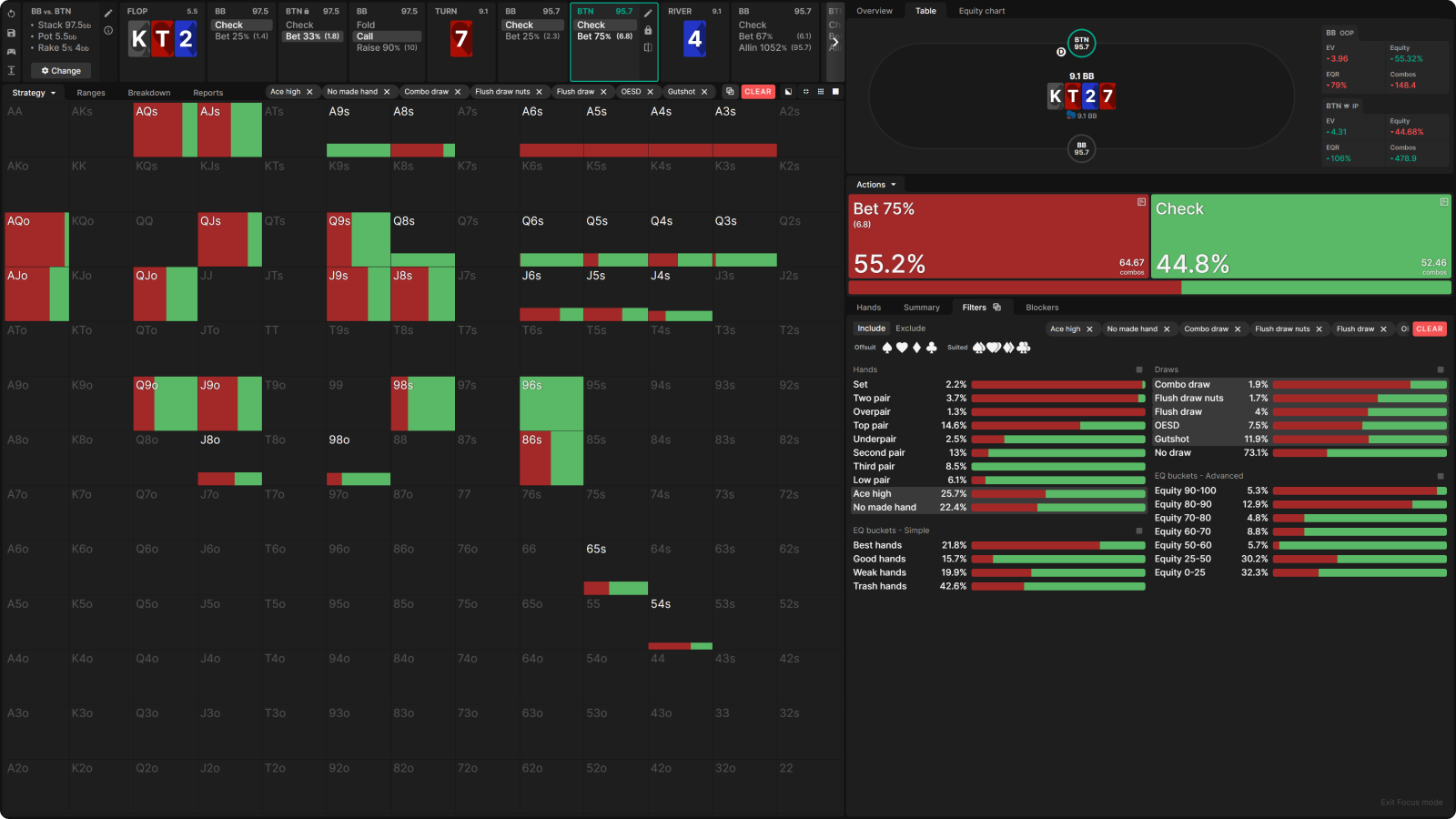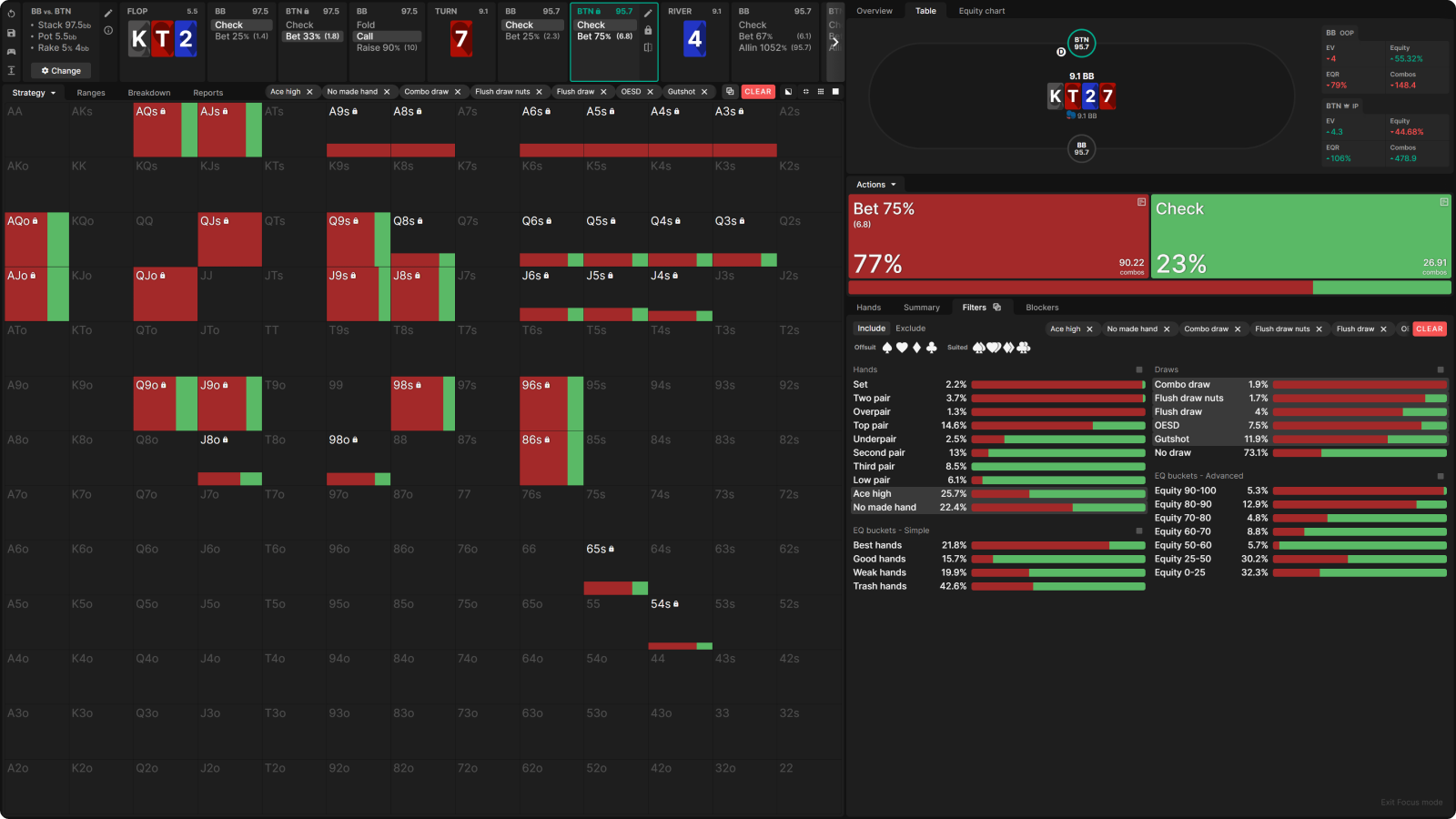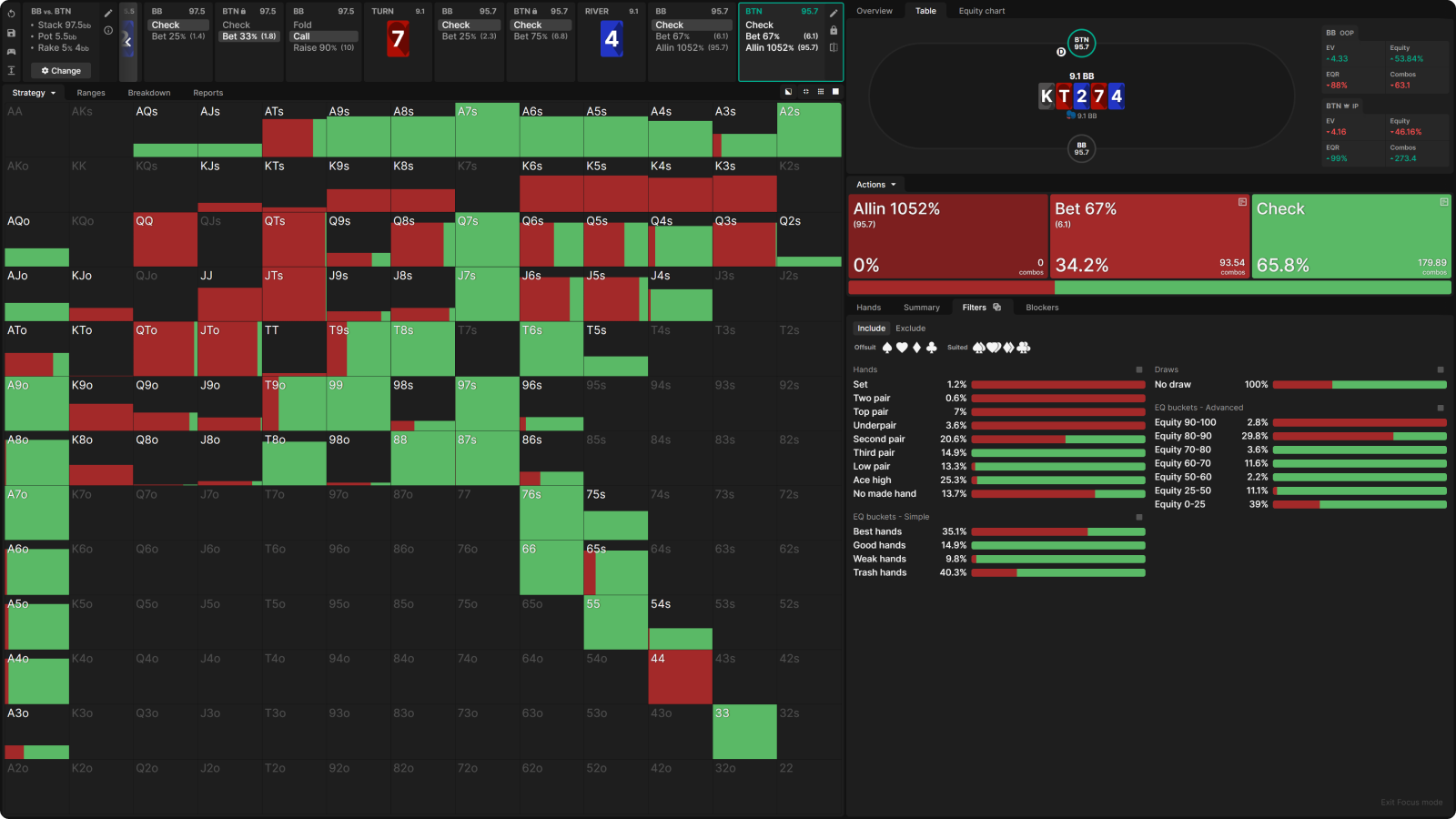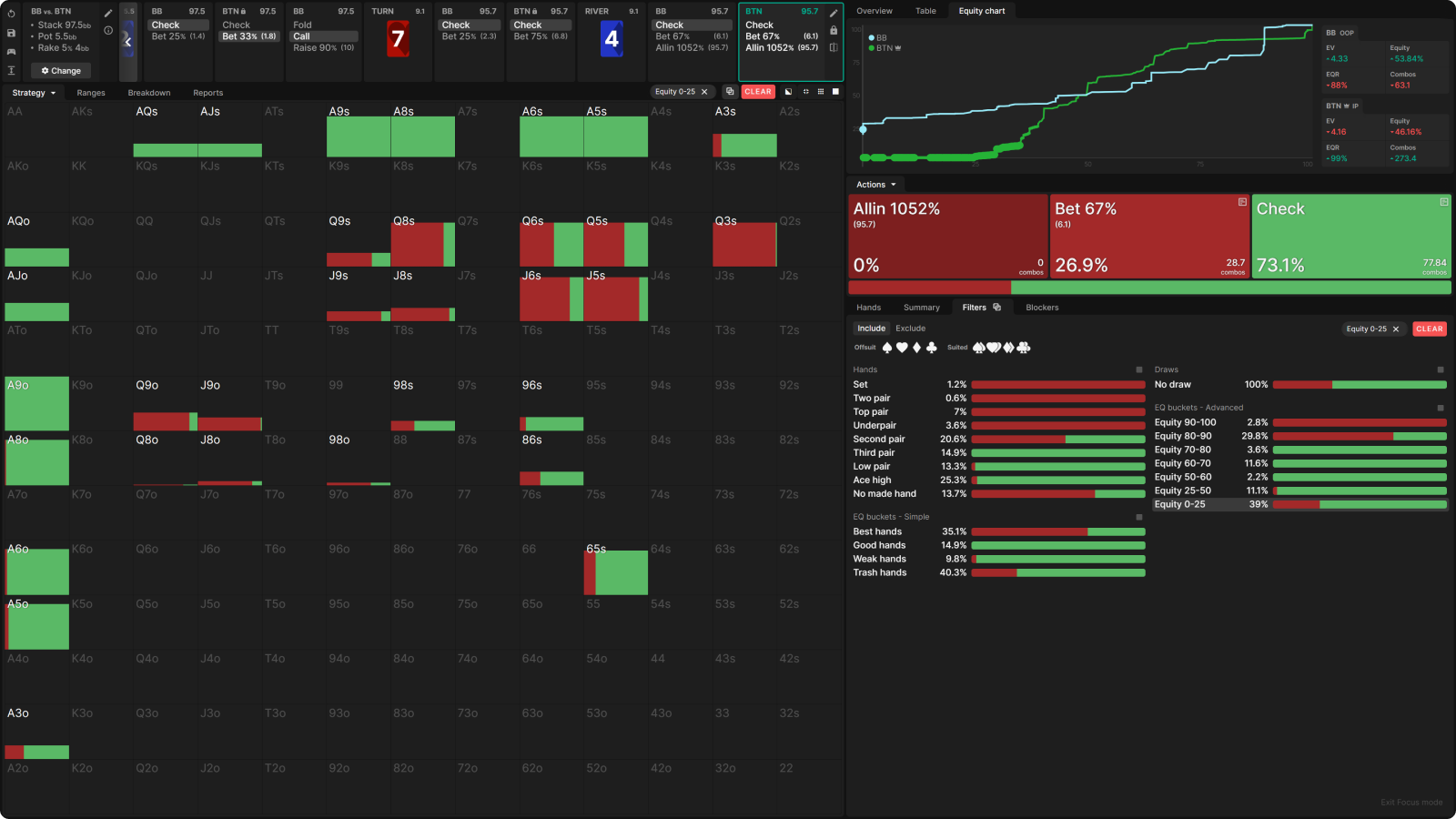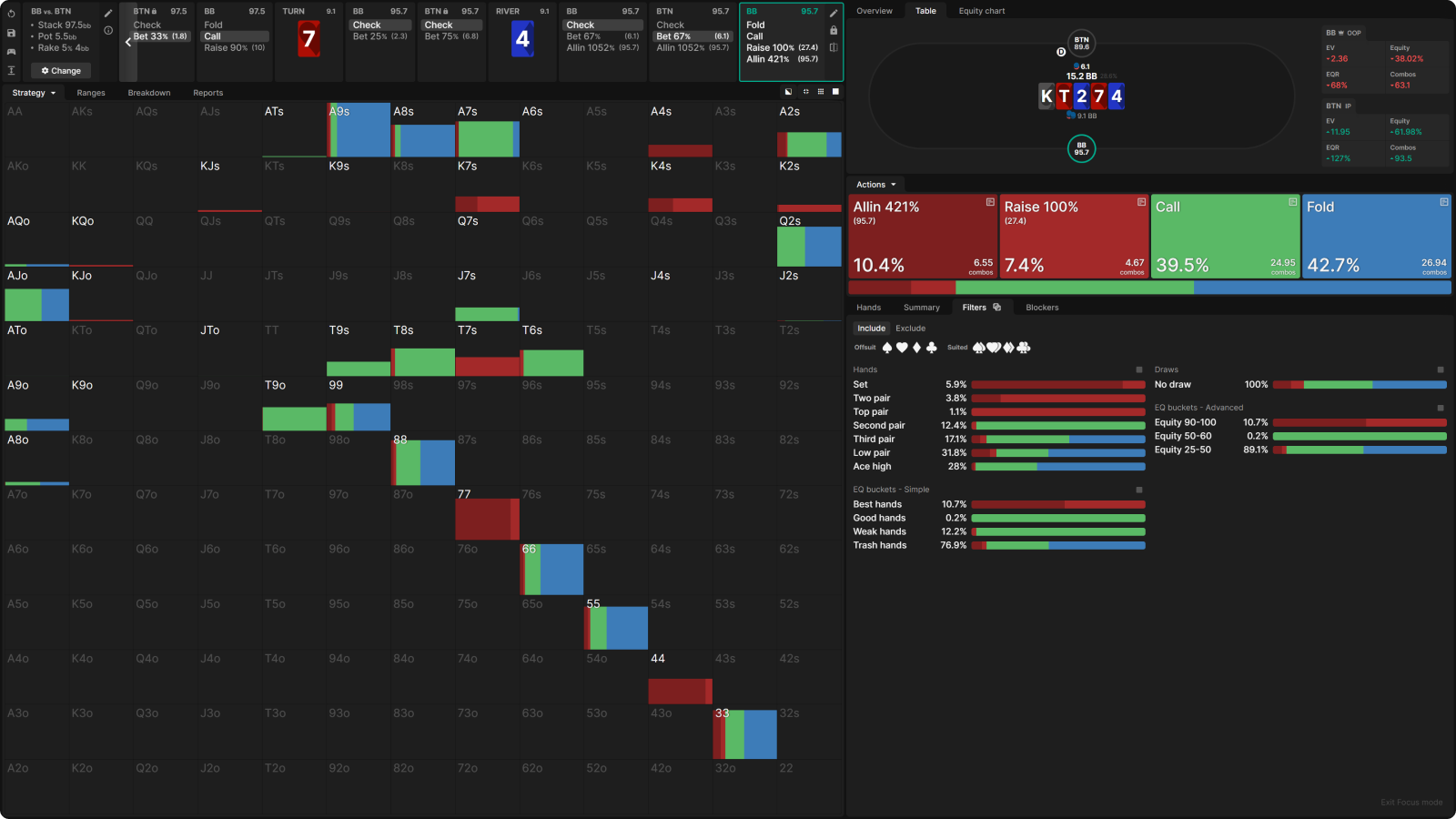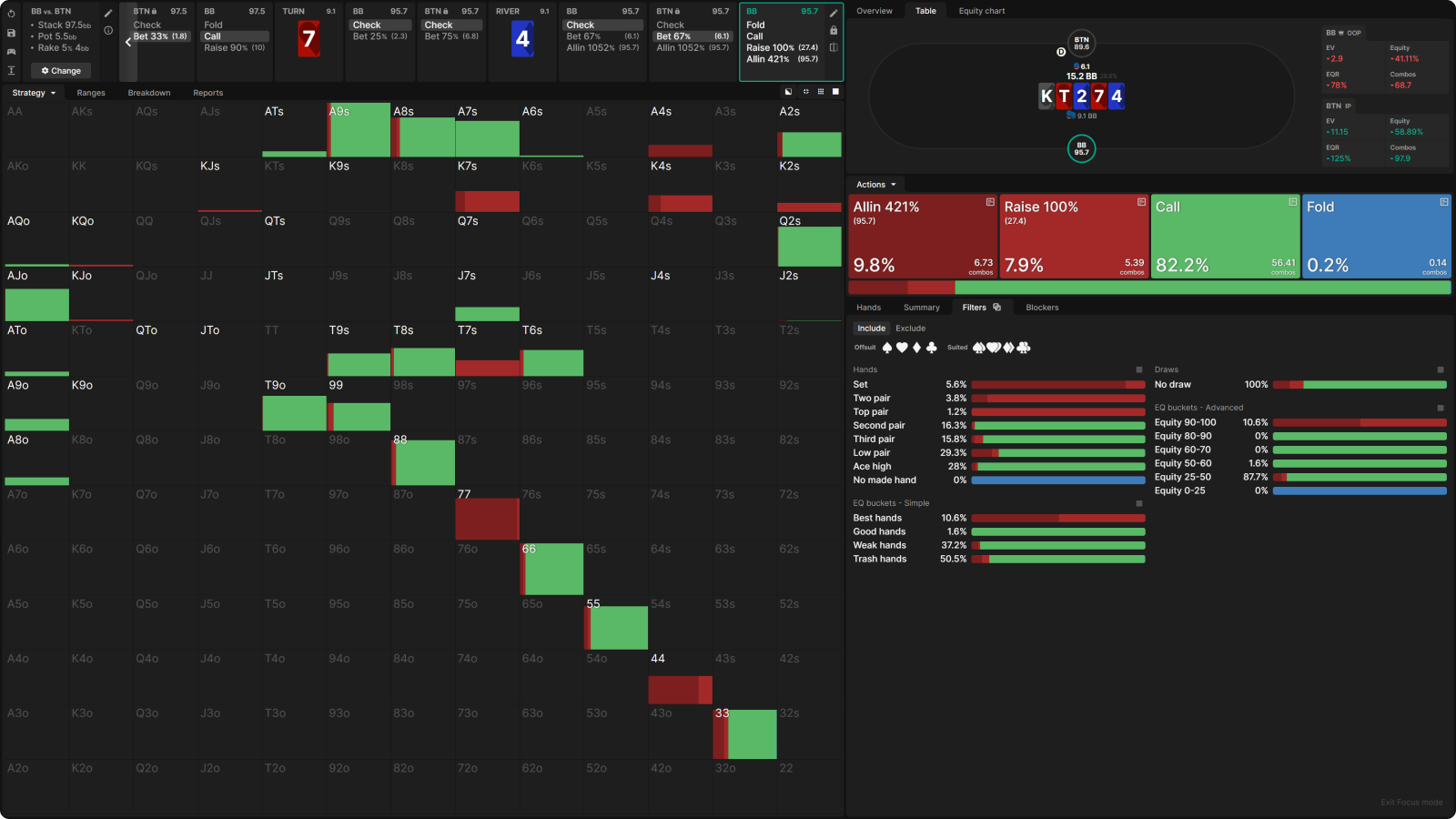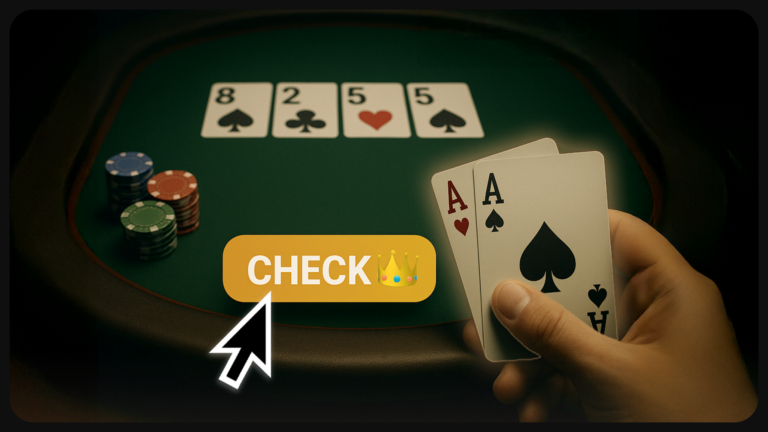Calling Down Over-Bluffed Lines in Lower Limits
If you are playing low stakes, chances are you have a plummeting red line in your tracker’s graph. If that sounds like you, have you asked yourself why that might be? There is a common misconception in poker that repeatedly comes up in discussions of hands played in low stakes:
While this is valid for certain spots, it’s also wrong in many other situations. This train of thought can quickly wreck your red line if you don’t think in ranges, keeping you from ascending to higher stakes.
The truth is that the general low-stakes population’s lack of study leads to suboptimal range construction and massive over-bluffing in spots with wide ranges. Today, we will lift the veil and prove with practical examples that calling down light is often not just reasonable but mandatory.
Let’s look at a pair of graphs to demonstrate my point:
- The first graph has been generated by your average low-stakes “ABC-reg.” Their red line is clearly tanking, losing their showdown winnings in the process (49% WWSFWon When Saw Flop (WWSF)
measures how often you win when you see a flop.). - The second graph is from a player who studies their opponents’ tendencies and exploits them by fighting more for pots when appropriate (54% WWSFWon When Saw Flop (WWSF)
measures how often you win when you see a flop.).
As you can see in the first graph, the red line is falling consistently without an end in sight. Clearly, the second player does something different than the first one, although both graphs are from 0.02/0.05$ Zoom on PokerStars.
To be completely honest with you, these two players’ graphs are actually both mine from when I was still playing at 5z. The right graph shows my “transformation” after I started fighting more for pots. In this article, I will make my case for how and when to raise your fighting spirit.
Key Signs To Look For When Bluff Catching In Low Stakes
Call Lighter More Often When:
- Their preflop range is wide, depending on their player profile and position (e.g., BTNvBB single-raised pot (SRP))
- Before they placed a bet postflop, their initial postflop range had not yet been filtered
- Your opponent is likely betting their whole range
- It’s unlikely that the community cards have improved their range, but they ignorantly or stubbornly bet often anyway, going against GTO’s recommendation
- They bet a size representing nutted hands that are missing from their range (e.g., overbetting in a spot when they can’t have the nuts)
Fold More Often When:
- Their preflop range is tight, depending on their player profile and position (e.g., EPvBB SRP)
- Their range had already been filtered considerably by aggressive actions earlier in the hand
- Their range hits the board well and, therefore, lacks enough bluffs (most players don’t find enough creative bluffs in these situations)
- Both ranges are uncapped, and they use an inappropriately large size (e.g., large c-bet on a board where both players can have the nuts)
We will explore two different spots to learn how to apply these concepts in real-life games. Be aware, though, that what we are going to discuss today is just a drop in the ocean. There are nearly infinite spots where we can call our opponents light. What I want to achieve with this article is to help you make better decisions and point you to some important factors to consider when facing bets to become tougher to play against.
Commonly Over-Bluffed Spots
1) Facing Turn Probes in Single-Raised Pots
Let’s look at an example board of J♠6♠5♣ T♥ to prove how easy it is for our opponents to be out of line when probingProbe bet
A bet made on the turn or river by the player who is out of position after the in position player chose not to make a continuation bet on, respectively, the flop or turn, despite being the aggressor on the street before. the turn on dynamic boards. I have chosen BTN vs BB as the example configuration, as it shows many of the key signs discussed earlier. Their range will be wide and unfiltered, and the turn hasn’t improved their flopped draws.
For the sake of this example, I have adjusted BB’s turn probe sizing from an optimal large overbet to 75% of the pot to create a more realistic scenario, as the low-stakes population doesn’t use overbets nearly as much as the solver does.
GTO BB Play
Before we apply any nodelocks, let’s first make some observations about BB’s GTO turn strategy to better understand the big picture of a balanced probing strategy.
Observation #1: The first thing that catches my eye is that BB is supposed to check to BTN a whopping 83% of the time on the turn.
Facing this strategy in lower stakes is very improbable, as we will see once we look into how various hand classes are supposed to play this spot. But why does this happen in GTO-land?
The reason OOP needs to check the turn so much is that the IP player checks back the flop and arrives at this node with a properly protected range that can withstand some heat to avoid being run over. IP accommodates their weaker holdings in this check-back range with some stronger holdings like overpairs, top pairs, and even some two pairs. However, they should exclude nutted hands from this range in most IP c-bet spots. That way, BB doesn’t have a clear “best” option for probing the turn and needs to play a mixed strategy with most of their hands.
Another reason OOP has to check 83% of the time is that on this board, they, as the BB preflop caller, lack some nutted hands such as TT+, which will 3-bet preflop. Even hands like AJ will sometimes 3-bet preflop, making it even more difficult for them to have a lot of high-equity hands on this board. Sure, most sets are also missing from our BTN range when we check back the flop, but our top pairs and overpairs make up for that gap. Therefore, as the BTN preflop raiser, we keep the equity advantage (albeit a very slim one), even when checking back the flop (BTN’s range equity after arriving on the turn is 50.88%).
Generally speaking, when the flop checks through, whoever has the equity advantage on the flop will usually retain it on the turn. This phenomenon happens because checking is fundamentally a means to reach showdown with hands that can win sometimes (realizing their equity). Because of that, BTN’s check-back range will contain plenty of hands ahead of Villain’s range.
Observation #2: BB’s turn strategy involves plenty of check-raising with their draws instead of probe-betting them.
Here, the frequencies are filtered for draws, and we can see that they are supposed to allocate their best draws in the probe-bet line only around 45% of the time:
When the solver doesn’t go for the bet with those draws, it often puts these draws into the check-raise line. Draws like open-enders or better are raised around 26% of the time after checking the turn! Gutshots mostly being check-folded.
Since OOP needs to check to us again most of the time, their draws follow suit and play roughly the same way. Having strong draws in both lines disincentivizes the BTN to bomb draw-completing rivers after the BB check-calls or check-raises on the turn. Keep in mind that flush draws like K♠4♠ or Q♠7♠, which can’t check-call the turn profitably as they are missing the required showdown value (SDV)Showdown value (SDV)
A hand that has a reasonable chance of winning at showdown unimproved. Often used to describe a medium-strength hand, in contrast with a very strong value hand or a very weak hand., will always probe the turn.
I think the point I’m trying to make is slowly becoming much clearer. BB’s turn strategy after the flop goes x-x is fairly complex and difficult to execute correctly. Playing straightforwardly by simply betting your good hands and draws is much easier (than going for tricky turn check-raises), which is what most likely happens in the games you’re playing, especially in low stakes.
GTO Response vs BB Turn Probe
Now, let’s take a closer look at BTN’s equilibrium strategy against BB’s turn probe and note our observations and underlying principles before we move to exploitative territory.
Observation: Looking at the filters, it becomes clear that our calling threshold revolves around second pair. Our 6-x, 5-x, and gutshots start mixing in folds.
We’re not going to discuss which lower pairs we need to call based on their (un)blockers because, in this context, card removal effects aren’t important to consider, as we will soon see. Instead, let’s zoom out and focus on the fact that this region of our range is indifferent (or close to it) against a balanced opponent. These are the hands that are the most sensitive to the opponent’s betting strategy, so let’s keep a close eye on them.
We will do some nodelocking with GTO Wizard AI to compare our response in equilibrium to our response vs an unbalanced turn probing strategy, but before that, let’s make some assumptions.
Mass data analysis (taken from low stakes) suggests that this is a spot where we can expect the average player’s betting range composition to consist of ~56% unmade hands. Based on that, our assumptions for how the BB will play this spot in lower limits are as follows:
- Not slowplaying high-equity hands enough – Two pair+ are usually bet
- Betting draws too often – Best draws are “fastplayed” most of the time, leading to severe over-bluffing
- They’re likely to find the correct bluffs – Most of the solver’s bluffs are fairly intuitive (as can be seen in the graphic below)
- While they bet draws more often, they still slowplay a lot of top pairs, making their betting range even more draw-heavy
Let’s nodelock BB’s strategy to mostly fastplay two pair+, with the occasional slow-play. According to the reference data I used, top pairs surprisingly don’t bet too often, which suggests that the pool is more comfortable with slowplaying top pairs than nutted hands. Their draws bet more often when having more equity. Combo draws and nut draws will always bet for the sake of the experiment, but it should be close to reality anyway. Flush draws and open-ended straight draws (OESD) usually bet, while gutshots are the draws that they will check most often. Sounds like an intuitive ABCABC
A straightforward and transparent strategy strategy to me! Keep in mind that your opponents don’t always play like this, but it’s a great starting point to understand the moving parts of our strategy.
Now, let’s look at how we should take advantage of this straightforward and transparent strategy:
Here, I have used GTO Wizard’s “Compare nodes” feature to compare our exploitative strategy to the equilibrium strategy after facing BB’s bet.
Looking closely at our new strategy against their turn probe, we can see that the adjustment is pretty easy. Remember our last observation? Our initial strategy had us mostly mixing call and fold (and sometimes raise) with weaker pairs, and I mentioned that these hands are the most sensitive to Villain’s strategy. Now, we can clearly see that, since our opponent is over-bluffing, we can always call the hands we were supposed to mix in folds with (99–77, 6-x, 5-x). Please keep in mind that I nodelocked Villain’s strategy conservatively. We might get away with calling this spot even lighter than we saw in the node comparison!
But What About the River?
We could look at what happens on the river, but I want to teach you fishing instead of giving you fish to eat. The underlying concept of calling hands purely—that otherwise would mix in folds at equilibrium—against an over-bluffing opponent, which we just saw on this turn node, can be applied on any node and street of the game tree.
Hands that mix calls and folds in theory do so because Villain’s bet size is strategically balanced, making them indifferent to calling and folding since no option is the best. The concept of indifference in poker is something that players should understand and apply. To help you grasp this, I’ve included a cheat sheet from Tombos21’s article on MDF & Alpha, which I highly recommend reading. This cheat sheet is a practical tool that showcases common bet sizes and their correct value-to-bluff ratios on the river, which need to be obeyed by our opponent so as not to get exploited.
It’s important to note that before the river, they can bluff more than pot odds on the river suggest, as their bluffs have equity and because they can use leverage to their advantage. This teaches us an important concept:
It’s easier to over-bluff rivers, as the optimal value-to-bluff ratios are more restrictive (towards bluffing) than on earlier streets.
If you find yourself on the river facing a bet, try to estimate if your opponent is bluffing enough according to this cheat sheet. If they are bluffing just a single combo more than they should, all of our indifferent bluff catchers become profitable calls and vice versa (we always fold when they are under-bluffing even slightly).
The other important thing to remember on the river when facing a bet with a bluff catcher is that:
When Villain has over-bluffed earlier streets, they arrive on the river with more bluffs than in theory, making it even easier to get out of line on the river.
So, next time you are confident that you need to over-call the turn exploitatively and the river is a complete brick, you should most likely close your eyes and call again. Yes, even with bottom pair! The reason is that many of your opponents will not know how to rate their bluffs on the river (check out example 2 from this relevant article), which will lead them to either massively over-bluff or under-bluff, depending on what we assume of the opponent. Now, before you go and station everyone down, keep in mind that the opposite is also true. If Villain under-bluffs earlier streets, there are simply fewer bluffs to choose from on the river. In that case, we need to over-fold massively.
2) Facing Bet-Check-Bet Lines As the Big Blind
Another node that our opponents will often misplay is the bet-check-bet node, especially when we expect them to bet their whole range (or close to it) on the flop. On rivers, the IP player will often need to give up a reasonable amount of bluffs to avoid over-bluffing since their flop action didn’t filter their range.
When your whole preflop range is still intact on the turn, over-bluffing rivers is very difficult to avoid.
To exploit that imbalance in their strategy, (again) it is generally a good idea to call their river bets lighter than usual. For instance, we can consider a dry example board of K♠T♥2♦ 7♥ 4♦ to demonstrate the heuristic in action. I have chosen a brick 7♥ turn specifically because I think it’s easy to misplay these turns after betting your whole range on the flop. Taking the river card into account is less important in this situation because I believe that they will make similar mistakes on any river card when finding themselves in the bet-check-bet node after the turn bricks.
To model the situation as close to reality as possible, I adjusted their turn c-bet size to 75% of the pot instead of using an overbet. Just like in the previous example, we will assume that the low-stakes population doesn’t know when to overbet. Hence, they tend to use a smaller bet size than what is optimal. Other than that, I nodelocked their strategy to bet 100% of the time with a 33% pot-sized bet on the flop. The reason behind this is that most players you will face at these stakes will “over-simplify” and bet their whole range (or close to it) for a small size on dry King-high flops, even though in this example, they are supposed to check back the flop around 27% of the time.
Analysis of Optimal Turn Play and Common Deviations From It
Let’s write down our observations again and break down their strategy to understand how they need to play the turn after they bet their whole range on the flop. Understanding the turn strategy will be essential to understand what ranges they will arrive at the river with.
We will first start by looking at some of BTN’s value bets on the turn:
Turn observation #1: After filtering for their top pairs, we see that they are supposed to mix in a decent amount of check-backs. Two pair+ is betting virtually always.
A balanced turn strategy requires putting a lot of top pairs into the check-back line. Mixing is necessary in most situations when considering a double barrel on the turn to avoid getting exploited when checking the turn instead. Not putting enough King-x into the checking line can be countered by the OOP player by bombing rivers with bluffs and value. Instead, I expect the BTN to bet top pairs slightly (~7%) more often:
Let’s now shift our focus toward BTN’s turn bluffs:
Here, I have filtered their range for airballs to find out how they should play their low-equity bluffs after range-betting the flop.
Turn observation #2: BTN needs to come up with crafty bluffs like Ace-high/Queen-high without a draw, as well as some bottom pairs. This sub-range bets ~21% of the time.
Villain will need to bluff some less obvious hands to remain unexploitable as played on brick turns, but why is that? Well, if they would only bet their draws as a bluff, OOP’s optimal strategy would be to over-fold bluff catchers (because the range they face is too strong), therefore improving OOP’s overall expectation. For that reason, they need to mix in low-EQ bluffs to stay unexploitable.
I expect them to construct their betting range mostly equity-driven, however. So I halved their betting frequency with this sub-range of unintuitive hands (although many might just never bet air here), which now looks like this:
We will look at BTN’s draws on the turn next:
Turn observation #3: When we filter for their high-EQ bluffs (draws), we can see that they are betting around 55% of the time.
Similarly to their top pairs, Villain needs to check their draws back frequently in theory. If IP’s strategy were to be betting draws all the time, they could get exploited on draw-completing rivers when checking back the turn by facing lots of pressure from the BB. Again, I expect them to bet way too equity-driven, so I nodelocked their draws on the turn to bet 77% instead of 55% of the time:
To conclude, we can summarize the imbalance of their turn strategy as follows:
- Fastplaying top pair – We assume that players in the lower limits will bet their top pairs on the turn too often
- Betting draws – Their draws will be put too often into the double barrel line
- Not betting airballs on the turn enough – Low-equity hands without a draw are very likely to check back the turn
We can see that their turn barrel range is too strong in terms of equity. Whenever you assume that your opponent bets too equity-driven, you should also conclude that their checking range should be weaker than it should, so let’s keep that in mind for later.
Analysis of Optimal and Exploitable River Play
Now that we have a general idea of BTN’s turn barrel strategy, we will focus on the bet-check-bet node specifically and examine BTN’s river equilibrium strategy (turn being nodelocked for IP) before we move on to find out how to read their soul 👻
River observation #1: Villain needs to be very selective with their thin value hands.
In this situation, the IP player needs to be a bit careful when betting their thinner made hands like second pair weak kicker. The reason for this is that our river landing range, as the BB, still contains plenty of Ten-x and some slow-plays to defend with. We shouldn’t have King-x anymore in our range as the BB since we fastplay these hands on the river.
River observation #2: The vast majority of their bluffs need to be checked back and given up.
We can see that the IP player is heavily disincentivized to bluff this node. Villain gives up around 73% of the time with any hand that has 25% equity or lower. This is quite unintuitive because checking back with hands that we know are almost always losing feels like a weak play to us humans. Solvers, however, conclude that they have to give up this node a lot because BTN’s value range at the river is heavily capped, and the river card being the 4♦ doesn’t help IP’s range in any meaningful way. Fold equity in this node is simply not enough to bluff any two. If you look at OOP’s overall equity, it shows that BB is a big favorite in this situation. If we changed the river to a card that completes draws, the BTN’s range would become uncapped again and, therefore, would bluff much more liberally.
If they were to play the hand optimally on the river after misplaying the flop and turn, we would need to defend like this:
First things first: what is our threshold for defending? While our hands that make a pair by hitting the board virtually always call, pocket pairs and Ace-x are indifferent to calling. As we saw in the last example, we will need to adjust our frequencies with these fringe hands specifically to exploit Villain.
Now, let’s move on to nodelock BTN’s river strategy combined with the nodelocks we applied on the flop and turn. We will assume that once they misplayed the turn, they will also misplay the river, which is a realistic assumption. Since I don’t have enough data after which I could model the situation realistically, I will show you how much deviation it takes from the BTN to incentivize us, as the BB, to make some extreme adjustments with our hands that would be indifferent at equilibrium. I’m sure you will be surprised with BB’s adjusted strategy:
You might think that it’s a ridiculous strategy to never fold here and that I applied a tremendous amount of changes to Villain’s strategy so that we have no folds on the river. The truth is that I only changed Villain’s strategy to bluff ~31% instead of ~27% of the time for our strategy to shift completely to never folding. Here is the proof:
Now, let’s just imagine for a moment how much more Villain is likely to be over-bluffing here and how much EV you have been leaving on the table by folding in these spots.
Conclusion
My intention with this article was to show you how to use GTO Wizard AI effectively to create exploits instead of trying to be balanced all the time against real-life opponents who are not balanced themselves. To summarize the big picture, these are the takeaways from this article:
- Players who don’t study GTO gameplay over-bluff more spots than you might think
- Studying our continuing thresholds for common spots in equilibrium helps us identify which hands we will first need to adjust our strategy with to exploit their tendencies
- Studying the GTO strategy of our opponents helps us identify where they might be deviating from it
Generally speaking, even though players in lower stakes are indeed passive overall, assuming that they never over-bluff any spot is one of the most overlooked leaks for players to fall victim to and can cost them significantly without even noticing.
Sometimes, these stationy strategies will lead you to make some calls, which might seem ridiculous at first. They could also lead you to lose some bigger pots with weak hands, but this is part of the learning journey. If applied correctly, you can expect your red line to stabilize from plunging to eternity and your win rate to soar.
I’m glad you made it to the end of this lengthy article, and I hope you got something out of it. Thank you for your time!
The BB’s incentives for calling an SB preflop raise differ from those of a cold-caller facing a raise from, say, LJ or CO. And the SB’s incentives for raising differ from those of an open-raiser in any other position.
Author
Sotirios “Sotos” Liakos
Sotos is a hobbyist, low-stakes cash game player, and poker theory nerd. He enjoys studying equilibrium strategies and identifying their driving principles.
Wizards, you don’t want to miss out on ‘Daily Dose of GTO,’ it’s the most valuable freeroll of the year!
We Are Hiring
We are looking for remarkable individuals to join us in our quest to build the next-generation poker training ecosystem. If you are passionate, dedicated, and driven to excel, we want to hear from you. Join us in redefining how poker is being studied.

